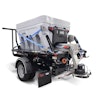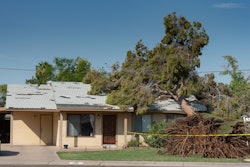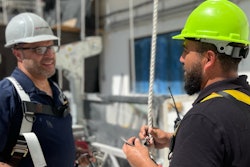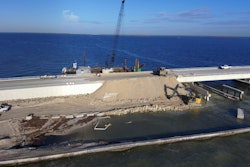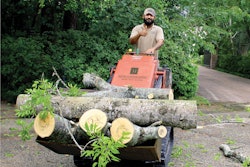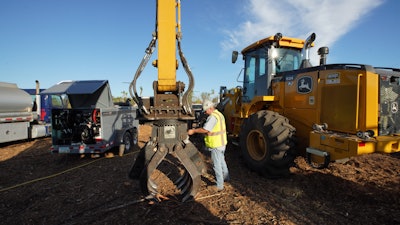
According to NOAA’s National Centers for Environmental Information, disasters in the last 20 years have caused more than $1 trillion in damages, with losses from this year’s disasters still being calculated.
The most common events have been severe storms, followed by tropical cyclones, flooding, drought, wildfires, windstorms and freeze.
Lyman Ramsay, president of Gulf Services, a family-owned business based in Theodore, Ala., providing turnkey construction services, is performing disaster recovery work in Florida’s Lee County area following Hurricane Ian. Gulf Services is one of many subcontractors to CrowderGulf, another family-owned Alabama company providing disaster recovery, debris removal and coastal restoration services throughout the United States. CrowderGulf holds preposition contracts throughout the country in the event of a disaster and holds the master contract for Lee County and its municipalities.
Fast Deployment of Debris Removal Professionals and Equipment Essential for Effective Post-Disaster Cleanup
Gulf Services operates four Debris Management Sites (DMS), where materials are brought in from what's collected from the right of way. Vegetative material is reduced through grinding. Construction and demolition (C&D) debris is reduced through compaction. Ultimately, the material goes to the landfill for final disposal.
Mulch is disposed of at several locations for landfill cover or landscape operations.
 Gulf Services commits its fleet to disaster cleanup sites as needed.PKA Marketing
Gulf Services commits its fleet to disaster cleanup sites as needed.PKA Marketing
Ramsay noted there are systems in place to where roles are assigned prior to mobilization, which has a short window of opportunity for placing assets.
“It’s important that we are here immediately following the event so we can assess the needs for the DMS,” Ramsay said. “Many times, the client has pre-identified these locations, and they've already been permitted. Therefore, it's a very quick turnaround to receive approval to begin site preparation.”
The company relays to other subcontractors the assets required to mobilize to the area. The work goes through several phases, starting with road clearing followed by debris collection, reduction and removal.
Additional services provided can include waterway debris and vessel removal and demolition.
When a disaster strikes, contractors can seek out opportunities to work in the recovery efforts by registering with local to national government entities such as FEMA and be prepared to supply required vendor documentation.
One month into the Hurricane Ian recovery and debris removal operation, the Crowder-Gulf team collected and reduced nearly two million cubic yards through a collaborative effort among many subcontractors from throughout the county. The goal was to make significant progress by Thanksgiving.
Ramsay noted the significance of pre-planning with clients and subcontractors for disaster clean-up as part of a playbook to mobilize and begin the recovery as rapidly as possible.
He said his company relies on those with experience in having the proper equipment and understand the urgency and the safety required for a successful mission.
Rapid mobilization is critical in the 48 hours before the traffic picks up from an influx of citizens who are returning to their homes, as well as the presence of contractors, aid groups, and other government agencies, Ramsay said.
Even after 48 hours, the mobilization continues with additional assets and working with local suppliers to provide more equipment and services, he added.
“Equipment breakdowns can occur at inopportune times. It can be a challenge to source from local vendors who are in the process of recovering, as well, so it may take more time for them to get back on track to provide what is needed,” said Ramsay, pointing to the need for preventative and general maintenance.
Chainsaws, generators and other equipment considered critical in clearing roadways and providing access to impacted areas may not be routinely used and need to be inspected regularly to ensure they function properly when needed.
Gulf Services brought two Thunder Creek multi-tank oil trailers to the Florida activation. The MTO 690 units enable workers to have the combination of different oils and lubricants needed to perform preventative and general maintenance work on location.
The units remove the CDL requirement and widens the availability of drivers, noted Ramsay.
“We eliminate the need of a service truck having to mobilize between different locations,” Ramsay said. “When the Thunder Creek units needs to be refilled, we hook it up and go to the local fuel supplier.”
Dust from grinding vegetative debris and processing of the C&D is significant, noted Ramsay.
“At any moment, the winds can change and we have to constantly monitor the air quality of our equipment,” Ramsay said. “Being able to address that with the air compressor and blower on this unit helps us keep that going like it needs to be.”
The units also include a light tower as a safety factor to offer visibility in the early morning and in the evenings as needed.
The Hurricane Ian debris removal job also has necessitated the use of Diamond Z DZT8000 tub grinders, a Diamond Z DZH7000 horizontal grinder and a Peterson 5710Z horizontal grinder.
Other equipment includes larger excavators such as Caterpillar 335s and 340s, John Deere 350 and Volvo EC350 to process the C&D, facilitate grinding operations and load out the reduced C&D and mulch to trucks taking the material to its final disposal.
Each location also has wheel loaders and dozers, including D6 Caterpillars and 700 series John Deeres.
“The purpose of the DMS location is to facilitate efficient and rapid collection of the debris from the right-of-way and reduce the cost associated with disposal,” said Ramsay.
Ramsay said his company keeps extra equipment in reserve at all times to backfill equipment that goes down.
The company rented several pieces of equipment from Alabama-based companies such as Beard Equipment and Thompson Tractor Company. Equipment also is sourced from companies in the affected area.
Equipment Maintenance, Fueling and Powering All Concerns on the Disaster Cleanup Jobsite
“Downtime is not an option, said Ramsay. “We're here to serve the citizens and their governments as effectively and fast as we can. This is critical to begin the rebuilding process and return to normal life as soon as possible. It’s all about throughput.”
Another challenge on disaster management sites is managing and working a fleet dealing with a variety of difficult material in a hot and dusty environment for long hours, said Ramsay.
Regarding fueling, Ramsay noted that “wherever we mobilize, the fuel is always difficult to obtain locally just due to the challenges local providers and their staff are facing from the storm.
Power is always a challenge as well.
“We know that going in, we will bring several loads of fuel and generators for the initial phases of the operation,” until local providers are able to meet those needs, noted Ramsay.
Housing, fuel, water and living conditions for workers is another challenge, underscoring the importance of having the right setup, assets and people to mobilize to the site as quickly as possible, Ramsay noted.
His company brings its own water tanker, generators, and RVs in order to be self-contained, self-sufficient and have the ability to work seven days a week from sun-up to sundown, and sometimes a little bit before and after, Ramsay added.
Matt Nelson, Diamond Mowers director of development, pointed out that those cleaning up damaged vegetation and trees following storms, floods, and forest fires need the right equipment for helping to return land to its natural state with equipment that can cut, shred, mulch, and process downed trees, broken branches, and burnt brush.
“After severe weather or fire, the land can be layered with hazardous trees and brush,” said Nelson. “Removing these hazards calls for the powerful processing and rotation speed of a disc mulcher. Engineered to act like a flywheel, the distinctive disc design combines stored energy with hydraulic power to enable operators to cut and mulch trees and brush in their path effectively and efficiently.”
Unlike other land-clearing techniques, mulching typically doesn’t cause disturbance to the soil, which is vital for reducing erosion and aiding in water conservation by preventing moisture loss as well as preparing the land for replanting and new growth, Nelson said.
Equipment Needed for Disaster Response Depends on Type of Damage Caused, from Vegetative to Flooding
- Most reclamation jobs may require a backhoe – essentially a tractor equipped with a loader-type bucket – to perform light-duty shoveling and material handling tasks.
- A brush cutter tackles land and vegetation management challenges from cutting through tall, thick grass to clearing large-scale brush and small trees.
- A bulldozer can push large quantities of scattered debris into piles for disposal, with its tracks providing enhanced stability and traction on treacherous terrain.
- A front loader/wheel loader acts like a mobile shovel that can lift, transport, and load debris onto vehicles for removal.
- A stump grinder uses a rotating cutting disc that mulches stumps. A reflex stump grinder uses a skid-steer’s lift arm to position its heavy-duty wheel in the stump before driving it through the wood with the machine’s wheels or tracks.
- A miller stump grinder enables the operator to cut stumps up to 36 inches in diameter without moving the carrier.
- For flooding damage, dehumidifiers dry out air in an enclosed space to prevent mold and bacteria growth.
- Fans of various shapes and sizes dry wet surfaces by moving the air around and helping moisture evaporate over time from both hard and soft surfaces.
- Flood pumps remove excess water from flooded areas.
- Heat drying equipment quickly evaporates moisture that remains on and inside property to prevent the development of mold, mildew, rot and other issues.
- Equipment for hurricane and storm damage repair includes backhoes and wheel loaders as well as cranes and crane trucks, which may be necessary for cleanup operations requiring lifting and transporting heavy objects.
- Dump trucks also are helpful.
- Excavators help rebuild a site after debris removal by digging holes for building foundations and performing trenching to reach, repair and replace damaged underground utility lines and piping systems.
- Track loaders – a heavier version of a wheel loader – perform better in the softer underfoot conditions that typically exist in flooded areas.
- Track-type tractors such as bulldozers or crawlers provide stability on uneven terrain to push large quantities of scattered debris into piles.
Associations, Corporations Offer Disaster Response Resources
Mark Miller, CCO of AEM – an environmental and technology company – noted that severe weather threatens national utility tolerance thresholds. His company’s technology is designed to help provide lightning and other critical severe weather data in seconds as to enhance resiliency and safeguard lives through more informed and faster decisions.
Caterpillar offers a wealth of input at cat.com/disasters that addresses preparedness on both a business and personal level as well as checklists for planning for emergency power needs, emergency compressed air, and emergency temperature control.
The Home Depot Rental offers large equipment, tools, trucks and trailers that can be used to support storm and disaster recovery efforts, the range of which can be found at https://www.compactpowerrents.com/disaster-cleanup-and-emergency-rentals/
“We closely monitor the stock levels and usage trends for storm-related products and partner with associates on the ground to identify areas with the most needs,” said The Home Depot Rental’s senior fleet manager, Truc Vo. “This allows us to pinpoint the optimal locations to deploy our Storm Response Units.”
The Home Depot Rental has two different trailer types to support contractors’ needs: 14-foot water restoration and remediation units, equipped with carpet blowers and a mix of compact and large dehumidifiers, and larger 53-foot disaster response units, which include the same water mitigation products as the smaller units plus water pumps, generators, chainsaws, and carpet cleaners.
Power generation is the strongest rental demand after a storm, notes Vo, adding The Home Depot Rental offers 2000-watt inverter generators to 6500-watt generators.
Another common need is water remediation equipment such as carpet blowers, dehumidifiers, and pumps.
“HEPA air scrubbers also play an important role by eliminating airborne contaminants when dealing with prolonged water damage such as after a major hurricane,” Vo said.
“Restoration and recovery efforts could extend for months. During this time, we experience rental demand for demolition, flooring removal and drywall repair tools.”
Skid steer loaders also are useful throughout clean-up he adds.
Vo noted that renting offers an economical alternative to buying and can be beneficial for short and long-term equipment needs, replacement of an owned asset that may be out of service or increased work volume.
The American Public Works Association (APWA) offers guidance on a number of disaster-related scenarios municipal entities might face, including APWA Natural Hazards Checklists to help agencies prepare for, respond to and recover from earthquakes, flooding, hurricanes, ice storms, tornados and wildfires. The checklists can be obtained at https://resourcecenter.apwa.net/ics-checklists/
The APWA also offers Equipment and Fleet Management Self-Assessment Toolbox, writing an emergency disaster plan and The Incident Command System Pocket guide documents.
Robert Garland, an APWA board member and vice president and regional director of McKim & Creed, has served as a consultant, first responder and contractor for natural disasters.
“Scenes can be chaotic, but a focused and controlled response can be executed with a properly developed and executed emergency preparedness plan,” noted Garland, adding it’s important to build flexibility in the plan.
“Public works agencies are truly the first responders after a natural disaster, removing debris from roadways and providing temporary restoration of roadways so that the firefighters, police officers, utility companies and emergency response contractors can access impacted areas, assess damages and provide relief,” said Garland.
He noted it’s critical to identify backup staffing and resources from offices not directly impacted by a disaster event so current workloads can be redistributed to maintain project schedules and achieve client expectations while also providing first response and recovery activities.
The APWA encourages public works agencies to develop mutual aid or inter-local agreements with other agencies to plan for the unexpected, said Garland.
“Immediately after Hurricane Ian made landfall on Florida’s southwest coast, public works agencies that were not impacted by the storm were immediately delivering needed equipment and staffing required to support the municipalities and counties that were impacted by the storm,” he added.
Sometimes it’s those providing disaster clean-up who need help themselves.
“First responders need to remain focused on their job at hand, even though many times their homes and families were also impacted by the event,” he said. The APWA’s Florida chapter maintains a Disaster Recovery Assistance Fund to assist public works employees and their families with the purchase of consumable goods and personal items following a natural disaster.
Many of McKim & Creed’s workers were directly impacted by Hurricane Ian and some were left without homes.
The company’s management team developed a plan to assess the personal needs of each employee and delivered water, generators, fuel and personal items to support their recovery.
Ramsay pointed out the strenuous work entails workers dropping their own personal plans to focus on the work, something that can be hard on families.
“Our employees are focused on the task at hand to get the operation going,” he said. “But once you slow down a bit, you start seeing the human side of this with devastation and suffering the citizens are going through. It's a humanitarian effort as much as anything to help these people get back to work and back to life.
“We’ll be here as long as it takes. I would expect debris removal operations for this mission to last at least a year.”

